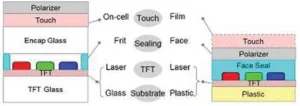A new article published by SID – Information Display discusses the challenges and barriers for creating the flexible AMOLED used in LG’s G Flex smartphone. The article describes the solutions LG developed to make the flexible display. Here is a short summary, for more information, please read the complete article on the SID website.
LG develops these flexible displays according to its roadmap which sees the development in three stages: durable, bendable and foldable/rollable. The roadmap does not have a timeline associated with it, but the stages refer to the bending radius which gets smaller and smaller until the display can be folded on itself. The G Flex display is a version of the first stage with a large bending radius.
The first image shows the structure of a glass based AMOLED with a flexible AMOLED.
The structures of a glass OLED display (left) and a plastic-based flexible OLED display (right) show not only that the latter enables a thinner panel, but that the order and composition of the stacks are very different.
The image shows that the stack is much thinner compared to the glass version and that the encapsulation is provided by the face seal covering the OLED emitters. This design creates the following issues.
Flexible plastic substrates with deposited low temperature poly silicon TFTs have a problem, as high performance TFT structures require a high temperature process that plastic substrates can’t deliver. LG has developed a new polyimide (PI) material with thermal durability of >500 degree C. Based on further development, LG improved the TFT structures to achieve a reliable TFT with good performance as shown in the second image.
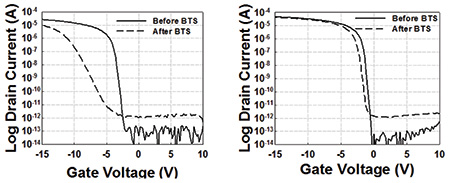 Performance improvements made to ELA-TFTs on PI are apparent in this comparison of early-stage development (left) to post-optimization (right).
Performance improvements made to ELA-TFTs on PI are apparent in this comparison of early-stage development (left) to post-optimization (right).
One of the key issues is the encapsulation of the OLED emitters that are very sensitive to humidity. The third image shows the barrier film structure comprised of inorganic and organic film structures.
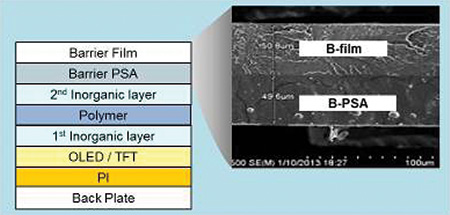 The face-sealing encapsulation structure is shown on the left. The image on the right is a cross-sectional view of the barrier film and barrier pressure-sensitive adhesive (PSA).
The face-sealing encapsulation structure is shown on the left. The image on the right is a cross-sectional view of the barrier film and barrier pressure-sensitive adhesive (PSA).
The company also had to develop a new chip on glass bonding process to avoid line defects in the produced panels. The key issue was the high thermal expansion of PI. LG developed a new structure in the fourth image.
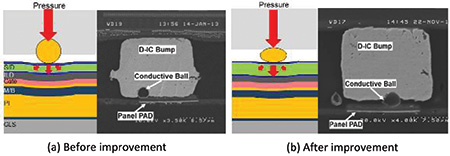 Researchers improved the chip-on-glass bonding process (shown in (a) before improvement) by replacing the conductive ball D-IC bump, as shown in (b), after improvement.
Researchers improved the chip-on-glass bonding process (shown in (a) before improvement) by replacing the conductive ball D-IC bump, as shown in (b), after improvement.
The thermal instability of plastic materials leads to lower performance, a drawback that can be avoided if the TFT structures are produced on a high temperature substrate and then transferred to the flexible substrate. This process exists for some time but applying it to large displays is difficult to say the least. LG has created a laser release process as shown in the fifth image.
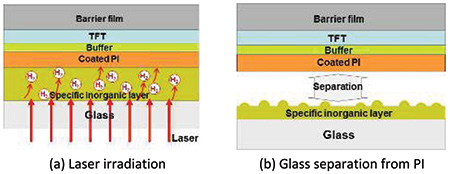 (a) Laser irradiation occurs on the glass. (b) The PI/TFT layer is then separated from the glass (b).
(a) Laser irradiation occurs on the glass. (b) The PI/TFT layer is then separated from the glass (b).
The process depends on an inorganic layer that releases hydrogen after irradiation with a laser. They are able to release the PI substrate without any change to the performance of the TFTs and emitters.
Besides the mentioned material and design developments, LG had also to make changes to the layout of the panel and edge chamfer to avoid cracks in lines near the edge of the display. There was also an issue with the final barrier coat cover that would leave areas open for moisture penetration.
This is a great summary of what it took to bring the flexible AMOLED panel to market. It also shows that it will not be easy to bring any high resolution display process to a flexible substrate especially in larger format. – Norbert Hildebrand

